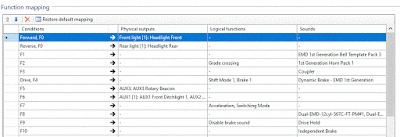Summary: Zero Stretching is an optional feature which allows operation of a
locomotive without a Multifunction Decoder installed.
Short Definition - Method of running a DC powered locomotive on DCC powered
rails.
Also known as Zero Bit Stretching in the Digital Command Control
specifications. May be informally referred to as Address 00. It may be
possible to power a single analog (non-decoder equipped) model locomotive by
itself or in addition to DCC equipped locomotives through a method known as
Zero Stretching. Refer to the documentation for the DCC system in use as it
is an optional feature, e.g.
Digitrax supports zero stretching at address 00
while
NCE does not.
Cautions
This feature was created to make DCC appealing during the early days. It
enabled migration while minimizing fears relating to the cost and installation
work required to upgrade to DCC. Zero Stretching is not part of the NMRA DCC
specification and as such, not all Digital Command Control systems support
Zero Stretching.
Note
Some locomotive manufacturers do not recommend operating a non-DCC decoder
equipped locomotive on a DCC system. Refer to the instructions before trying
your new locomotive on a DCC powered track.
Decoderless Locomotives on a DCC Layout
To operate a locomotive which is not equipped with a decoder, the DCC waveform
on the rails is modified. This modification affects the "zero pulse". The DCC
waveform has a DC value of zero (15V - 15V = 0), so when zero stretching or
analog mode is not in use, a non-decoder equipped locomotive will not move.
The DCC waveform normally consists of symmetrical pulses, two of which equal
one cycle. Under these conditions no torque is produced in the motor.
As shown, the Zero Pulse consists of a pulse, with a nominal duration of 100
micro seconds (µS). The complete cycle is 200µS. Under normal conditions the
voltage of the pulse is canceled by the second one in the cycle.
How Does it Work?
To implement Zero Stretching, half the zero-bit cycle is modified. One of the
pulses can be made a lot longer in duration than the other, which will cause
current to flow for a longer period of time. By controlling which half of the
cycle is longer, the direction of the motor can be determined. The command
station will make the necessary changes to the DCC signal to create the
desired effect, based on the throttle's input. As locomotive speed increases
the command station will create more Address 00 packets.
Since the data packet consists of eight bits, a total of 16 pulses will appear
on the rails (two per bit). Which is 1.6mS in total. So, it is possible for
the stretched bit to equal 1.5mS. The speed is determined by the amount of bit
stretching and the rate at which Address 00 packets appear. Zero Stretching
will not produce as much torque as using pure DC will.
A zero pulse, two of which equal DCC Waveform, illustrating zero bit stretching.
Any pulse between 90 and 110µSecs is one cycle.
Important Warnings
Caution: Because of the frequency of current flow changes and the harmonics
present, DC motors will heat up much more quickly than they would on an analog
power source, and
some motor types can be seriously damaged with only a brief
encounter with DCC track. Many motors will buzz and hum when presented with
this type of power. In the early days of DCC there was an unfounded fear that
zero stretching would cause motors to overheat, destroying them and melting
the body. Those fears were never realized.
-
Do not leave locomotives that are not equipped with a decoder on the track
-
All direct current locomotives will respond to the signals created by Zero
Stretching. Which may have unintended results.
Coreless Motors - subject of a future post
Coreless motors and other types of precision motors should not be used on a
DCC powered track (unless a DCC decoder is installed). Normally, current flow
is limited by the back EMF that a motor generates when it is spinning, but the
DCC waveform is full voltage all the time, even when address 00's throttle is
closed, the zero stretching is at a minimum, and the motor is stopped. The
waveform is not high enough in frequency for the low inductance to limit the
current flow when there is no back EMF, so the windings look like a short.
They lack the iron core to sink the heat generated by excessive current flow,
which will kill them very quickly.
Bandwidth
As locomotive speed increases, more bandwidth will be demanded of address 00,
which can have an impact on response times when more than 5 DCC equipped
locomotives are also in operation. This technique is a bandwidth hog due to
the need to constantly send packets addressed to 00.
Thanks to the DCC Wiki for a lot of this information.
If you have an idea for a blog post here, let me know. If I can comment on it, I will or I'll see if someone else can and post it.







